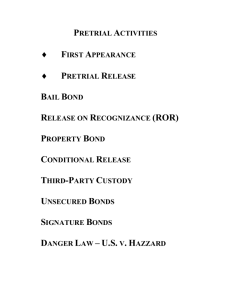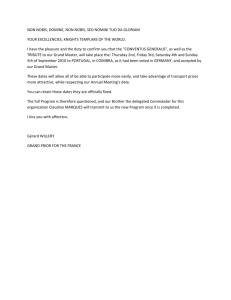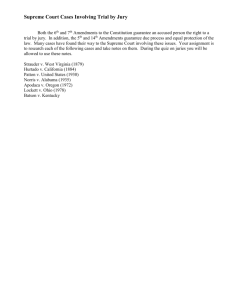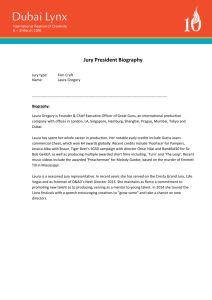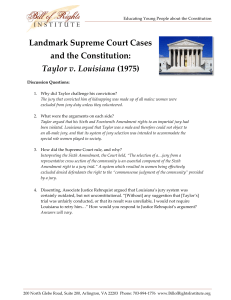Brief - Reporters Committee for Freedom of the Press
advertisement
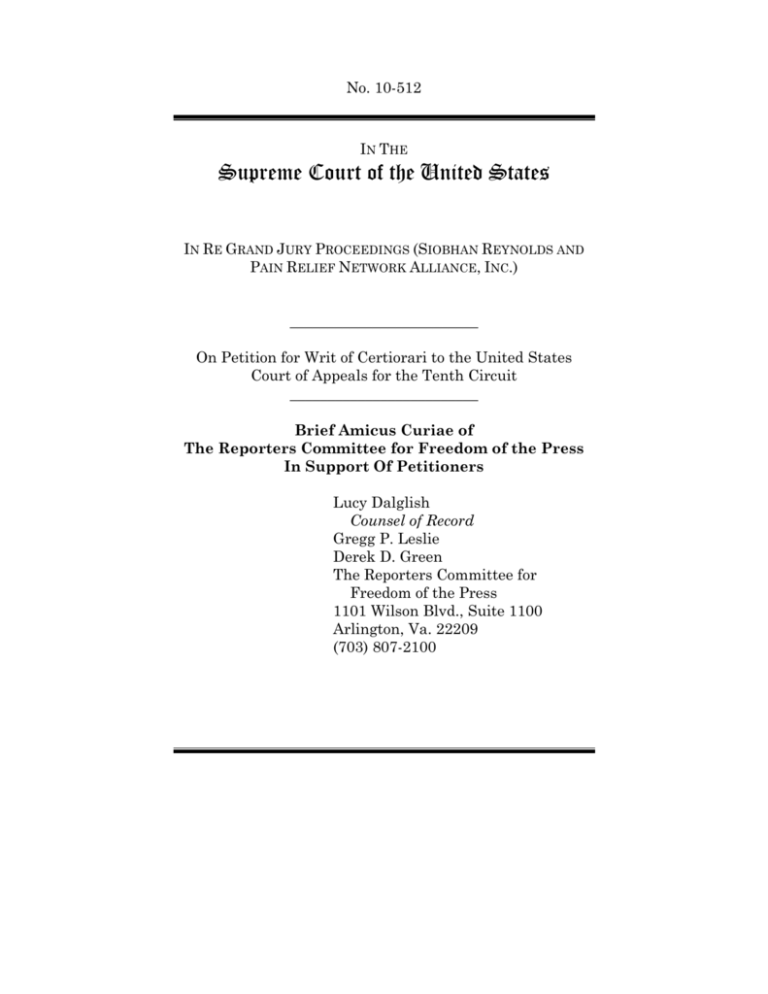
No. 10-512 IN THE Supreme Court of the United States IN RE GRAND JURY PROCEEDINGS (SIOBHAN REYNOLDS AND PAIN RELIEF NETWORK ALLIANCE, INC.) _________________________ On Petition for Writ of Certiorari to the United States Court of Appeals for the Tenth Circuit _________________________ Brief Amicus Curiae of The Reporters Committee for Freedom of the Press In Support Of Petitioners Lucy Dalglish Counsel of Record Gregg P. Leslie Derek D. Green The Reporters Committee for Freedom of the Press 1101 Wilson Blvd., Suite 1100 Arlington, Va. 22209 (703) 807-2100 i TABLE OF CONTENTS TABLE OF AUTHORITIES ....................................... ii STATEMENT OF INTEREST ................................... 1 SUMMARY OF ARGUMENT .................................... 1 ARGUMENT ............................................................... 4 I. This Court should grant review to reconcile conflicts among lower courts as to what standard of review applies to grand jury subpoenas that target expressive activities. ..... 4 II. This Court should grant review to provide guidance as to what type of investigation qualifies as one conducted “in good faith.” ............................ 8 III. This Court should grant review to resolve the conflicting interpretation and practice by this Court and the various Courts of Appeals regarding their authority to seal entire case files in matters that are ancillary to grand jury proceedings........................................................ 14 A. The complete sealing of the record below conflicts with the precedent of other circuit courts of appeals. ......................................... 15 B. The lower courts’ sealing of the entire court file is at odds with this Court’s established practice of deciding issues of constitutional importance in public. ................................... 19 CONCLUSION.......................................................... 23 ii TABLE OF AUTHORITIES CASES Ark. Writers’ Project v. Ragland, 481 U.S. 221 (1987)............................................. 5 Brandenburg v. Ohio, 395 U.S. 444 (1969) ................ 5 Branzburg v. Hayes, 408 U.S. 665 (1972) ........................................ 8-9, 14, 20, 21, 23 Buckley v. Valeo, 424 U.S. 1 (1976) ............................ 5 Communist Party of Ind. v. Whitcomb, 414 U.S. 441 (1974)............................................. 5 Fort Wayne Books, Inc. v. Indiana, 489 U.S. 46 (1989) .............................................................. 7 Holder v. Humanitarian Law Project, 130 S. Ct. 2705 (2010)......................................... 6 In re Dionisio, 442 F.2d 276 (7th Cir. 1971) (per curiam).................................................. 20-21 In re Grand Jury 95-1, 59 F. Supp. 2d 1 (D.D.C. 1996)....................................................... 4 In re Grand Jury Matter, 906 F.2d 78 (3d Cir. 1990) .................................................... 15 In re Grand Jury Proceeding, 842 F.2d 1229 (11th Cir. 1988) ............................................. 4, 12 In re Grand Jury Proceedings, 776 F.2d 1099 (2d Cir. 1985) ...................................................... 4 In re Grand Jury Proceedings Involving Eve Rosahn, 671 F.2d 690 (2d Cir. 1982)................ 15 iii In re Grand Jury of S. Dist. of Ala., 508 F. Supp. 1210 (S.D. Ala. 1980) ........................................ 10 In re Grand Jury Subpoena, 97 F.3d 1090 (8th Cir. 1996) ................................................... 15 In re Grand Jury Subpoena, Judith Miller, 438 F.3d 1138 (D.C. Cir. 2006) (per curiam)............................................ 17-18, 20 In re Grand Jury Subpoena, Judith Miller, 397 F.3d 964 (D.C. Cir. 2005), as modified and reissued, 438 F.3d 1141 (D.C. Cir. 2006) ........................................... 17, 20 In re Newark Morning Ledger Co., 260 F.3d 217 (3d Cir. 2001) .................................................... 18 In re Oliver, 333 U.S. 257 (1948) .............................. 22 In re Special Grand Jury 89-2, 450 F.3d 1159 (10th Cir. 2006) ................................................. 19 LaRouche v. Webster, 566 F.Supp. 415 (S.D.N.Y. 1983) ................................................. 10 Levine v. United States, 362 U.S.610 (1960)................................ 15, 16, 22 Marcus v. Search Warrants, 367 U.S. 717 (1961)...... 7 N.Y. Times Co. v. Sullivan, 376 U.S. 254 (1964) .... 6-7 Regan v. Time, Inc., 468 U.S. 641 (1983) ................... 5 Reporters Comm. for Freedom of the Press v. Am. Tel. & Tel. Co., 593 F.2d 1030 (D.C. Cir. 1978) ............................................. 9, 10 Shelton v. Tucker, 364 U.S. 479 (1960) .................... 13 United States v. Calandra, 414 U. S. 338 (1974) ..... 22 iv United States v. Dionisio, 410 U.S. 1 (1972) ....... 20-21 United States v. Doe, 465 U.S. 605 (1984) ............... 22 United States v. R. Enterprises, Inc., 498 U.S. 292 (1991) ............................................................ 21-22 Zurcher v. Stanford Daily, 436 U.S. 547 (1978) ........ 7 RULE Fed. R. Crim. P. 6...................................................... 15 OTHER AUTHORITIES Government’s Motion Pursuant to Local Rule 83.2.3, United States v. Schneider, No. 07-10234-MLB (D. Kan. Apr. 4, 2008) ....................................... 11 Roxana Hegeman, Associated Press, Pain-relief advocate target of secret federal probe, Wichita Eagle, Aug. 22, 2010 ........................... 16 Adam Liptak, Column, Outspoken Activist’s Case Becomes Tangled in Secrets, N.Y. Times, Nov. 2, 2010, at A22, available at 2010 WLNR 21880557 ................................. 11-12 Alexander Meiklejohn, The First Amendment is an Absolute, 1961 Sup. Ct. Rev. 245 (1961) ............ 6 Amy Pomerantz Nickerson, Comment, Coercive Discovery and the First Amendment: Towards a Heightened Discoverability Standard, 57 UCLA L. Rev. 841 (2010) ............. 6 Eugene Volokh, Deterring Speech: When is it “McCarthyism”? When is it Proper?, 93 Cal. L. Rev. 1413 (2005) ................................ 5 1 STATEMENT OF INTEREST1 The Reporters Committee for Freedom of the Press is a voluntary, unincorporated association of reporters and editors that works to defend the First Amendment rights and freedom of information interests of the news media. The Reporters Committee has provided representation, guidance and research in First Amendment and Freedom of Information Act (“FOIA” or “the Act”) litigation since 1970. SUMMARY OF ARGUMENT Disagreement exists among lower courts as to the standard of review they should apply to grand jury subpoenas that seek expressive activities and, thereby, infringe the subject’s First Amendment rights. Although this Court has not directly addressed the issue, its decisions reflect the recognition that pro- Pursuant to Sup. Ct. R. 37, counsel for amicus curiae declare that they authored this brief in total with no assistance from the parties (one of amicus' legal fellows who participated the the drafting of this brief, Derek Green, is on a full-time leave of absence from the firm representing Petitioners in this matter, but has had no involvement in the representation of Petitioners); that no individuals or organizations other than the amicus made a monetary contribution to the preparation and submission of this brief; that written consent of all parties to the filing of the amicus brief has been filed with the Clerk; and that counsel for both parties were given notice of the intent to file this brief more than 10 days before this brief was due to be filed (amicus notified the Solicitor General 10 days before the filing deadline, but was required to file earlier when the Solicitor General chose not to file a response; however, an earlier filing by this amicus in this case, a Motion to Intervene of Oct. 7, indicated the involvement and intent of the amicus much earlier). 1 2 tected expressive activity may be chilled when it is the target of the government’s compulsory process or other investigations. The potential for such a chilling effect supports the Court’s acceptance of this case and its ruling that a heightened standard of review should be applied to grand jury subpoenas that impinge on constitutionally protected activities. Such a holding is consistent with Supreme Court jurisprudence providing enhanced procedural protections in other First Amendment contexts, including libel and obscenity law. Although this Court has emphasized that the government may issue a grand jury subpoena only pursuant to a “good faith” investigation, it has not indicated the specific type of conduct that would fall short of this standard. Courts do not opt to examine prosecutorial decision-making often or lightly, and they generally reject attempts to interfere with investigations by federal prosecutors, even when First Amendment rights are implicated. However, in “the rarest of circumstances,” courts may find that examination of a prosecutor’s “good faith,” or lack thereof, is warranted. A number of factors in this case, including an unsuccessful attempt to obtain a prior restraint against the subject before subpoenaing her and an avoidance of the “good faith” determination by reliance on the prosecutor’s mere assurances that she conducted the investigation “in good faith,” are sufficient to raise concerns about whether the government met its burden. In light of these circumstances, this Court should set a standard for determining when prosecutors act in less than “good faith” in subpoenaing witnesses exercising their First Amendment rights. 3 Along similar lines, review by this Court also is appropriate in order to curb the inappropriate and unnecessary use of secret dockets in judicial proceedings that are ancillary to grand jury investigations. The sealing of the entire record in the District Court and Court of Appeals is inconsistent with the precedent of other circuits, and is at odds with this Court’s established practice of deciding issues of constitutional importance in public. 4 ARGUMENT I. This Court should grant review to reconcile conflicts among lower courts as to what standard of review applies to grand jury subpoenas that target expressive activities. A clearly established, heightened standard of review should apply to grand jury subpoenas that directly burden speech or other activities protected by the First Amendment. The jurisprudence governing the standard to be applied when one’s First Amendment rights conflict with the evidentiary needs of prosecutors is widely disparate, presumably because this Court has not weighed in on the issue. Compare, e.g., In re Grand Jury Proceedings, 776 F.2d 1099, 1103 (2d Cir. 1985) (utilizing a two-step test requiring the existence of a “compelling” governmental interest and a “substantial relation” between the information sought and the subject of the compelling state interest), with In re Grand Jury 95-1, 59 F. Supp. 2d 1, 10 (D.D.C. 1996) (following Fourth Circuit jurisprudence, declining to require the heightened standard of a compelling governmental interest and substantial relationship to the investigation). Although the authority is fractured, much of the analysis is animated by the knowledge that protected expressive activity is chilled when it becomes the target of the government’s compulsory process. See e.g., In re Grand Jury Proceeding, 842 F.2d 1229, 1235–36 (11th Cir. 1988) (“The Supreme Court recognized the difficulties of formally proving the evils of chill and harassment, however, and accordingly required only that minor parties show ‘a reasonable probability that the compelled disclosure ... will sub- 5 ject them to threats, harassment, or reprisals from either Government officials or private parties.’” (quoting Buckley v. Valeo, 424 U.S. 1, 74 (1976))). Indeed, the government’s use, or misuse, of the grand jury process to silence its critics is alarming and violative of a fundamental First Amendmentbased doctrine: The government may not undertake certain actions to combat what it views, for whatever reason, as dangerous speech. See generally Eugene Volokh, Deterring Speech: When is it “McCarthyism”? When is it Proper?, 93 CAL. L. REV. 1413 (2005). For example, it may not imprison someone for the mere advocacy of racist speech, Brandenburg v. Ohio, 395 U.S. 444 (1969), or ban from the electoral process political parties that want to run on unpopular views. Communist Party of Ind. v. Whitcomb, 414 U.S. 441 (1974). The same should be true of the grand jury process. The government should not be able to frighten citizens into refraining from exercising their First Amendment rights of expression, advocacy and association by threatening them with compulsory process — at least not without first satisfying a heightened standard of scrutiny. To do otherwise would allow a content-based regulation on speech to survive without withstanding the proper constitutional test, a notion that directly contravenes this Court’s well-established First Amendment jurisprudence regarding content-based regulations. See, e.g., Ark. Writers’ Project v. Ragland, 481 U.S. 221, 230 (1987) (“Regulations which permit the Government to discriminate on the basis of the content of the message cannot be tolerated under the First Amendment.” (quoting Regan v. Time, Inc., 468 U.S. 641, 649 (1983))). 6 In addition to guaranteeing the right of free speech, the First Amendment provides protection from government interference with those activities that assure self-governance, including “[p]ublic discussions of public issues, together with the spreading of information and opinion bearing on those issues.” Alexander Meiklejohn, The First Amendment is an Absolute, 1961 SUP. CT. REV. 245, 257 (1961). Certainly, that protection must extend to public discourse about and advocacy against government prosecutions. After all, as a dissent in this Court recently noted, “[t]hat … speech and association for political purposes is the kind of activity to which the First Amendment ordinarily offers its strongest protection is elementary.” Holder v. Humanitarian Law Project, 130 S. Ct. 2705, 2732 (2010) (Breyer, J., dissenting) (emphasis in original). Moreover, this Court has provided enhanced procedural protections in other First Amendment contexts, notably libel, as prophylactic rules to diminish self-censorship and other risks associated with chilling effects. See Amy Pomerantz Nickerson, Comment, Coercive Discovery and the First Amendment: Towards a Heightened Discoverability Standard, 57 UCLA L. Rev. 841, 876 (2010). Perhaps the strongest example is the Court’s recognition in one of its landmark opinions that free expression must have “breathing space” to survive and, as such, the inevitable “erroneous statement … in free debate … must be protected.” N.Y. Times Co. v. Sullivan, 376 U.S. 254, 271–72 (1964). The Sullivan Court also announced that libel plaintiffs must prove actual malice by convincing clarity, rather than the more relaxed preponderance of the evidence standard and required the Supreme Court to make an independent exami- 7 nation of the whole record before the trial and appellate courts “so as to assure ourselves that the judgment does not constitute a forbidden intrusion on the field of free expression.” Id. at 285. In imposing the burden of proving the falsity of the allegedly defamatory statement on the plaintiff, as opposed to the defendant having to prove the truth of what he or she wrote, the Court noted that under the latter standard, “would-be critics of official conduct may be deterred from voicing their criticism, even though it is believed to be true and even though it is in fact true, because of doubt whether it can be proved in court or fear of the expense of having to do so.” Id. at 279. The Court also has afforded extra procedural protection to allegedly obscene material, noting that the Fourth Amendment’s requirement of probable cause may be inadequate when the search or seizure targets expressive material. See Marcus v. Search Warrants, 367 U.S. 717, 731 (1961) (requiring the judge, before issuing a warrant for its seizure, to determine whether particular material is obscene, since “the use of these warrants implicates questions whether the procedures leading to their issuance and surrounding their execution were adequate to avoid suppression of constitutionally protected publications”). See also Fort Wayne Books, Inc. v. Indiana, 489 U.S. 46 (1989); Zurcher v. Stanford Daily, 436 U.S. 547, 564 (1978) (“Where the materials sought to be seized may be protected by the First Amendment, the requirements of the Fourth Amendment must be applied with scrupulous exactitude.”) (citation and internal quotation marks omitted). Thus, adoption of a heightened standard of review for grand jury subpoenas that implicate protected 8 First Amendment activities finds support in public policy, as well as this Court’s jurisprudence. As such, the Court should hear this case to clearly define what that standard requires. II. This Court should grant review to provide guidance as to what type of investigation qualifies as one conducted “in good faith.” A grand jury subpoena with indicia that it was issued in an attempt to quell protected speech cannot qualify as one conducted “in good faith,” and, in those cases, the government must provide additional information about its motives. Although this Court has declined to grant journalists a First Amendment-based privilege not to testify before grand juries, it has recognized that “news gathering is not without its First Amendment protections.” Branzburg v. Hayes, 408 U.S. 665, 707 (1972). As the Court explained: [G]rand jury investigations if instituted or conducted other than in good faith, would pose wholly different issues for resolution under the First Amendment. . . . We do not expect courts will forget that grand juries must operate within the limits of the First Amendment as well as the Fifth. Id. at 707–08. Justice Powell, who cast the necessary fifth vote to support the judgment, noted in his concurrence that the Court did not hold that the government is free to annex the media as an investigative arm and elaborated on the majority’s warning that harassment would not be tolerated. He wrote: 9 If a newsman believes that the grand jury investigation is not being conducted in good faith he is not without remedy. Indeed, if the newsman is called upon to give information bearing only a remote and tenuous relationship to the subject of the investigation … he will have access to the court on a motion to quash and an appropriate protective order may be entered. Id. at 710 (Powell, J., concurring). Because the Court emphasized that “the obligation of reporters to respond to grand jury subpoenas [is the same] as other citizens,” id. at 682, one can logically conclude the converse — that the “good faith” requirement is no less applicable to citizens exercising their First Amendment rights than it is to journalists. Since Branzburg, however, this Court has not fully fleshed out what constitutes a “good faith” investigation or, perhaps more significantly, what action qualifies as less than “good faith.”2 In light of the fact that this language seems to provide the only First Amendment protection in the grand jury setting, a Although courts loosely use the terms “good faith” and “bad faith” when describing the grand jury subpoena standard, e.g., Reporters Comm. for Freedom of the Press v. Am. Tel. & Tel. Co., 593 F.2d 1030, 1075 (D.C. Cir. 1978), the terms are not interchangeable. That is, nothing in Branzburg indicates that a prosecutor must act “in bad faith.” Rather, Branzburg requires only that an investigation be conducted “in good faith.” The distinction is significant, as lack of “good faith” is a significantly more relaxed standard than “bad faith.” 2 10 clear standard governing the types of conduct or activities that could qualify as each is needed. Courts do not lightly choose to interfere with prosecutorial discretion in this area, but in exceptional circumstances they must examine the “good faith” of the government. Indeed, courts have generally rejected attempts to interfere with investigations by federal prosecutors, even when First Amendment interests are implicated. See Reporters Comm. for Freedom of the Press v. Am. Tel. & Tel. Co., 593 F.2d 1030 (D.C. Cir. 1978) (denying two newspapers’ request for injunctive and declaratory relief from a telephone company policy of providing toll-call records to law enforcement officials, holding that the First Amendment provided no additional shield respecting privacy interests beyond the Fourth Amendment’s protection in the context of a good faith criminal investigation); LaRouche v. Webster, 566 F.Supp. 415 (S.D.N.Y. 1983) (denying declaratory and injunctive relief from a U.S. attorney’s investigation into a congressman’s campaign after a series of newspaper stories indicated potentially illegal campaign-financing activities). Noting that “[t]he decision to investigate, like the decision to prosecute, is one which the Constitution places in the executive branch,” the Webster court held that the constitutional separation of powers prevents courts from interfering with the exercise of prosecutorial discretion “except under the rarest of circumstances.” Id. at 417. See also In re Grand Jury of S. Dist. of Ala., 508 F. Supp. 1210, 1213 (S.D. Ala. 1980) (“the petitioners have failed to carry the heavy burden necessary to warrant the type of extreme interference with the grand jury process”) (emphasis added). 11 Amicus submits that this case is a good example of those rare circumstances justifying court examination of prosecutorial discretion. From the limited amount of information available from recently unsealed but still heavily redacted pleadings and popular-press coverage of the issue, a strong case can be made that the government tried to silence Siobhan Reynolds’ speech, not because it suspected her of any criminal wrongdoing but because the prosecution found her troublesome to its case. (Pet’rs’ Pet. 5–6.) In trying to convince the trial court that a presumptively unconstitutional prior restraint was warranted in the criminal prosecution to which she was not a party, the prosecution said that “Siobhan Reynolds [was] contacting victims and witnesses in an effort to influence, harass, and/or intimidate them.” Government’s Motion Pursuant to Local Rule 83.2.3 at 8, United States v. Schneider, No. 07-10234-MLB (D. Kan. Apr. 4, 2008). Its only support for such a claim, however, was a newspaper article stating that one of the defendants’ former patients “began working with” Reynolds, who traveled to Wichita to “generate public sympathy for the incarcerated doctor and his wife.” Id. When it was unable to stifle her activities through a prior restraint, the government, in the exercise of its prosecutorial discretion, issued a sprawling grand jury subpoena that had nearly 100 subparts and “sought documents, e-mails, phone records, checks, bank records, credit card receipts, photographs, videos and ‘Facebook communications (including messages and wall posts)’ concerning contacts with dozens of people, including doctors and lawyers, along with information about a billboard supporting the [defendants] and a documentary film 12 called … ‘The Chilling Effect.’ ” Adam Liptak, Column, Outspoken Activist’s Case Becomes Tangled in Secrets, N.Y. TIMES, Nov. 2, 2010, at A22, available at 2010 WLNR 21880557 (quoting the subpoena). These facts suggest that the government may have been punishing Reynolds for her speech, and should be sufficient to indicate a lack of good faith. As such, amicus asks this Court to review the case and reexamine the “good faith” nature of the investigation in a more public format. The lower courts would be well-served by specific guidance from this Court as to what constitutes a “good faith” investigation. The Eleventh Circuit has pointed out that “[i]t is unclear from the case law precisely what factual showing, if any, [an objecting subpoenaed witness] must make to establish that its freedom of association would be impinged by enforcement of the subpoena.” In re Grand Jury Proceeding, 842 F.2d at 1235. As stated above, many of the facts underlying this case suggest an intentional infringement on First Amendment rights. That is, the presence of several of the following factors would seem to signal a grand jury investigation not being conducted “in good faith”: The absence of any law-violation allegations against the subject, whose sole role in the underlying prosecution is one of advocacy; Unsuccessful attempts to obtain a prior restraint against the subject; A subpoena calling for production of irrelevant material and an unduly burdensome demand for production of documents; 13 A subpoena insufficiently specific with respect to the materials to be disclosed; Avoidance of the question of “good faith” by allowing the prosecutor to simply attest to such with no further showing; An across-the-board sealing of both the trialand appellate-court dockets. When an objection from a witness that a subpoena impinges on his or her First Amendment rights is accompanied by any of the above factors, mere assurances from the government that it issued its subpoena “in good faith” cannot survive constitutional muster or a heightened standard of review that should apply to subpoenas seeking expressive materials. At the very least, the witness must be able to question the government about its suspicious motives in an adversarial process overseen by a court that is required to make particularized findings on the record. After all, as this Court noted almost 50 years ago: Even though the governmental purpose be legitimate and substantial, that purpose cannot be pursued by means that broadly stifle fundamental personal liberties when the end can be more narrowly achieved. The breadth of … abridgment must be viewed in the light of less drastic means for achieving the same basic purpose. Shelton v. Tucker, 364 U.S. 479, 488 (1960). This Court should grant review to definitively establish — for both reporters facing grand jury sub- 14 poenas, as well as other citizens at whom they are directed — what an investigation conducted “in good faith” entails. Otherwise, Justice Powell’s reminder that “the newsman … [who] believes that the grand jury investigation is not being conducted in good faith … is not without remedy,” is simply meaningless. For, as the disclosed facts in this case suggest, a standard-less definition of “good faith” will allow governmental attempts to silence its critics by stifling their protected activities. Branzburg, 408 U.S. at 710 (Powell, J., concurring). III. This Court should grant review to resolve the conflicting interpretation and practice by this Court and the various courts of appeals regarding their authority to seal entire case files in matters that are ancillary to grand jury proceedings. The decision of the U.S. Court of Appeals for the Tenth Circuit to seal the entire case file in this matter presents a stark example of the unresolved tensions that remain between the public’s right of access to the courts and a court’s interest in maintaining secrecy of grand jury proceedings. This Court should grant the petition in order to correct the Tenth Circuit’s apparent3 misapplication of the authority to order the complete sealing of a record in which the Because the Tenth Circuit’s opinion remains sealed, with no publicly available order explaining the justification for secrecy, see Pet’rs’ Pet. at 1 n.1, amicus is left to presume the reasons for the Tenth Circuit’s decision to seal the entire case file. 3 15 facts are already publicly known and the traditional grounds for secrecy carry no force. A. The complete sealing of the record below conflicts with the precedent of other circuit courts of appeals. By completely sealing the record of the ancillary grand jury proceedings here, the Tenth Circuit has interpreted the need for grand jury secrecy, whether based on Federal Rule of Criminal Procedure 6(e) or some other authority, in a manner that is not consistent with other circuit courts of appeals. This Court should grant the petition in order to correct the disparate practices of federal courts in the various circuits regarding the propriety of sealing hearings and court records in ancillary grand jury proceedings. The lower courts’ sealing of the entire record in this matter cannot be reconciled with the approach taken by a number of other courts of appeals that have expressly held that, at a minimum, portions of civil contempt proceedings for non-compliance with a grand jury subpoena must be public. See, e.g., In re Grand Jury Subpoena, 97 F.3d 1090, 1095 (8th Cir. 1996); In re Grand Jury Matter, 906 F.2d 78, 86-87 (3d Cir. 1990); In re Grand Jury Proceedings Involving Eve Rosahn, 671 F.2d 690 (2d Cir. 1982). In Rosahn, for example, the Second Circuit relied on this Court’s reasoning in Levine v. United States, 362 U.S. 610 (1960), to hold that non-public civil contempt proceedings, which carry the same possibility of imprisonment as criminal contempt proceedings, implicate the same Due Process concerns as nonpublic criminal contempt proceedings: 16 Given the burden that imprisonment imposes on an individual, a civil contempt trial that could result in an order of confinement carries with it the same concerns and purposes that lead to the requirement of a public trial in the criminal context, such as the need to assure accountability in the exercise of judicial and governmental power, the preservation of the appearance of fairness, and the enhancement of the public’s confidence in the judicial system. Although a contempt trial may properly be closed to the public when substantive grand jury matters are being considered, no reason is advanced for preventing a defendant from having the rest of his trial in public. Rosahn, 671 F.2d at 697 (citation omitted). Those same concerns — accountability in the exercise of judicial and governmental power, preservation of the appearance of fairness, and public confidence in the judicial system — are undoubtedly also present when a court not only threatens to imprison4 a grand jury witness but also seals all records in the matter. See Petition at 24 (“. . . Petitioners were ordered to pay fines and threatened with imprisonment . . .”). The press has also reported that Reynolds faced “imminent jailing for contempt.” Roxana Hegeman, Associated Press, Pain-relief advocate target of secret federal probe, Wichita Eagle (online posting date Aug. 22, 2010), available at http://www.kansas.com/2010/08/22/1456739/schneider-advocate-targeted-in.html (last accessed Nov. 4, 2010). 4 17 The sealing of the entire record by both the U.S. District Court and the Tenth Circuit is also irreconcilable with the approach taken by the U.S. Court of Appeals for the District of Columbia in proceedings arising out of the investigation into the disclosure of Valerie Plame’s identity. Unlike the approach of the District Court and the Tenth Circuit in the present matter, the D.C. Circuit publicly affirmed the District Court’s findings of contempt and refusal to quash grand jury subpoenas that were issued to reporters in that matter. In re Grand Jury Subpoena, Judith Miller, 397 F. 3d 964 (D.C. Cir. 2005), as modified and reissued, 438 F.3d 1141 (D.C. Cir. 2006). Combined, the published opinions by the District Court and the Court of Appeals in the Miller matter explain in general terms the purpose of the underlying grand jury investigation, see 438 F.3d at 1143-44, the information sought by the prosecutor (including the specific subject of the testimony and documents sought), id., and the legal analysis of the courts. Unlike the Tenth Circuit’s action in this case, the D.C. Circuit approved the sealing and ex parte submission of certain records in relation to the ancillary proceedings (and a portion of a concurring opinion was redacted), but published its analysis in a reported opinion. In fact, the D.C. Circuit issued an additional opinion explaining its reasoning for subsequently unsealing additional portions of record. In re Grand Jury Subpoena, Judith Miller, 438 F.3d 1138, 1140 (D.C. Cir. 2006) (per curiam) (citing circuit precedent for “the common-sense proposition that secrecy is no longer ‘necessary’ when the contents of grand jury matters have become public”). 18 If anything, the argument for grand jury secrecy in the Miller matter was much stronger than in the present case. Miller involved the reputations and potential criminal culpability of Bush Administration officials over the possible leaking of classified information. See 438 F.3d at 1142-43. The political and national security ramifications at issue in that investigation are simply not present in this case. Yet the D.C. Circuit still managed to discuss most of the contempt issues — the issues arising from proceedings ancillary to the grand jury investigation itself — publicly. Even some circuits that have taken more restrictive views of disclosure under Federal Rule of Criminal Procedure 6(e) have recognized that the Rule does not support the complete sealing of ancillary matters. The Third Circuit, for example, has held that it is permissible to seal ancillary contempt proceedings at an initial stage, but not for the full adjudication. In In re Newark Morning Ledger Co., 260 F.3d 217 (3d Cir. 2001), the Third Circuit affirmed the U.S. District Court’s sealing of “initial filings and motions” in an ancillary proceeding based on the lower court’s holding that, after reviewing the material, it would subsequently “open the proceedings and disclose all non-grand jury material.” Id. at 227-28. Citing prior circuit precedent, the Third Circuit approved this approach, noting that the district court “should complete its review of the proceedings and after determining what, if any, materials contain secret grand jury information, unseal all non-secret material.” Id. at 228 n.18. Here, even the court’s legal reasoning — and, indeed, the dockets themselves, see Pet’rs’ Pet. at 1 n.1 19 — remains off-limits to the public. This approach is inconsistent with the Tenth Circuit’s own precedent. In In re Special Grand Jury 89-2, 450 F.3d 1159 (10th Cir. 2006), the Tenth Circuit held that “legal files” are protected by Criminal Procedure Rule 6(e) secrecy “to the extent” that those filings “disclose grand jury proceedings.” Id. at 1176. Notably, however, the Tenth Circuit recognized that the court’s legal analysis and record of proceedings were not — and should not be — secret: Of course, purely legal argument, without reference to what occurred before the grand jury, needs no protection. But the district court's public orders, as well as this opinion, adequately disclose those matters. Perhaps more can properly be disclosed, but that can be better determined during the proceedings on remand, which we order. Id. (emphasis added). By sealing the entire record, the Tenth Circuit has foreclosed the public review of even “purely legal argument.” The Tenth Circuit’s opinion in In re Special Grand Jury reflects that the court’s decision here is in conflict with not only the practice of other courts, but also the Tenth Circuit itself. B. The lower courts’ sealing of the entire court file is at odds with this Court’s established practice of deciding issues of constitutional importance in public. This Court has a long history of publicly deciding important issues of constitutional and procedural significance that arise out of proceedings ancillary to 20 grand jury investigations. The approach taken by this Court in such cases serves as a roadmap for how appellate courts should publicly address the legal issues while still protecting grand jury secrecy. A review of a few of these cases demonstrates how far astray the Tenth Circuit’s approach was here. This Court’s opinion in Branzburg v. Hayes, supra, provides a primary example. Like the present case — and like the Miller case in the D.C. Circuit, supra — the consolidated matters reviewed in Branzburg all involved witness challenges on First Amendment grounds to grand jury subpoenas. But unlike the Tenth Circuit’s approach, this Court publicly announced its holding in Branzburg. The Court’s opinion summarized the underlying grand jury investigations, the challenged subpoenas, and the procedural histories of the cases at issue, see 408 U.S. at 667-679, using this factual context as a background for explaining the Court’s reasoning on an important issue of constitutional law. See, e.g., id. at 689-91; see also id. at 708-09 (“Grand juries are subject to judicial control and subpoenas to motions to quash. We do not expect courts will forget that grand juries must operate within the limits of the First Amendment as well as the Fifth.”) The opinion contains no suggestion that such a discussion somehow violated grand jury secrecy. This Court took a similar approach later that same year in United States v. Dionisio, 410 U.S. 1 (1972), holding that neither the Fourth nor Fifth Amendment provided grounds for a witness to oppose a grand jury subpoena that sought a voice exemplar from the witness. The Seventh Circuit had held — also in a published opinion — that a witness had a 21 Fourth Amendment right not to provide the voice exemplar to a grand jury. In re Dionisio, 442 F.2d 276 (7th Cir. 1971) (per curiam). This Court’s opinion discussed in detail the underlying grand jury investigation and the procedural history of the case. The opinion described why the grand jury was convened (“to investigate possible violations of federal criminal statutes related to gambling”), specific evidence that the grand jury had received (“certain voice recordings that had been obtained pursuant to court orders”), and the evidence at issue in the court challenge (“voice exemplars for comparison with the recorded conversations that had been received in evidence”). See 410 U.S. at 2-4. It also discussed how Dionisio and other witnesses challenged the subpoena, and the lower court rulings with respect to Dionisio. See 410 U.S. at 3-4, 13. Again, there was no indication that the Court’s opinion somehow violated grand jury secrecy. This Court’s opinion in United States v. R. Enterprises, Inc., which concerned an attempt by three businesses to avoid complying with a grand jury subpoena, follows the same pattern. 498 U.S. 292, 294 (1991). The Court identifies the businesses and subpoenas at issue, describes the underlying grand jury investigation, and summarizes the proceedings below. Id. at 294-98. Although the Court’s opinion noted the “strict secrecy requirements” of grand jury proceedings required by Federal Rule of Criminal Procedure 6, the Court did not suggest that an appellate court’s legal analysis of the ancillary proceedings should be sealed. Id. at 299. Branzburg, Dionisio, and R. Enterprises are just a few of cases in which this Court has publicly decid- 22 ed issues of constitutional and procedural importance arising out of judicial proceedings ancillary to grand jury investigations.5 This approach reflects the premise that grand jury secrecy is not absolute, and does not justify extraordinary measures that infringe on other deeply-held values. See, e.g., Levine, 362 U.S. at 618-19 (concluding that grand jury secrecy did not support shutting out the public from criminal contempt adjudication). The Tenth Circuit should have, but did not, approach the present case in the same manner. As the Court explained in Levine, there is “no further cause for enforcing secrecy” with respect to those parts of the ancillary court proceedings that do not necessarily disclose actual grand jury deliberations or secrets. Id. at 618. The total secrecy mandated by the Tenth Circuit in the present case is at odds with this Court’s long history, and reflects an apparent misinterpretation of grand jury secrecy that must be addressed. See also, e.g., In re Oliver, 333 U.S. 257 (1948); Levine v. United States, 362 U.S. 610 (1960), United States v. Calandra, 414 U. S. 338 (1974), United States v. Doe, 465 U.S. 605 (1984). 5 23 CONCLUSION This Court should grant review in this case in order to clarify the standard of review when a grand jury investigation implicates the First Amendment rights of a witness. In particular, the Court must clarify when the conduct of an investigation may be seen as in less than good faith, to fully realize the protections under the First Amendment that the Court first noted in Branzburg v. Hayes, supra. In addition, the Court should find that the complete sealing of matters ancillary to a grand jury proceeding is improper when there is no demonstrated need for secrecy, and when a less restrictive alternative, such as redacted filings, is available. Amicus asks this Court to accept review, so that it can give guidance to appellate courts about when dockets and records should be presumptively open, with any particular redaction and sealing done subsequent only to a demonstrated, narrowly tailored need for confidentiality. Respectfully submitted, Lucy A. Dalglish Counsel of Record Gregg P. Leslie Derek D. Green The Reporters Committee for Freedom of the Press 1101 Wilson Blvd., Ste. 1100 Arlington, VA 22209-2211 (703) 807-2100 November 8, 2010



